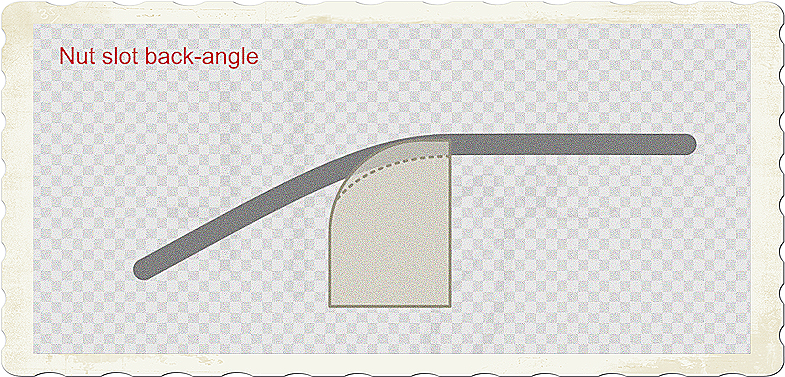
 |
|
#1
|
|||
|
|||
|
I’ve noticed that the intonation on the low E on my Martin D-42 is a little sharp.
The other strings seem OK which makes me wonder if it has anything to do with the way the saddle is intonated toward the pins. (See pic). The strings are Martin SP 80/20 Extra Lights. I don’t recall having this issue when I had mediums on it, but I’d expect the problem to be worse with mediums. Last edited by Quickstep192; 04-05-2024 at 04:46 PM. |
|
#2
|
|||
|
|||
|
If you want to stay with extra lights, your saddle will need to be re-intonated. But before doing that, relief and nut slot height should be checked and adjusted if needed.
__________________
Rick Ruskin Lion Dog Music - Seattle WA |
|
#3
|
||||
|
||||
|
Quote:
you fret further up the neck.
__________________
Derek Coombs Youtube -> Website -> Music -> Tabs Guitars by Mark Blanchard, Albert&Mueller, Paul Woolson, Collings, Composite Acoustics, and Derek Coombs "Reality is that which when you stop believing in it, doesn't go away." Woods hands pick by eye and ear
Made to one with pride and love To be that we hold so dear A voice from heavens above |
|
#4
|
|||
|
|||
|
Saddle angle is a compromise. Martin chose a shallow angle which tends to exhibit slightly sharp intonation on the 6th string, even when compensated as far back toward the pins as possible.
Increasing the saddle angle will improve the sixth string intonation, but it will tend to produce flat intonation on the 4th and 5th strings. |
|
#5
|
||||
|
||||
|
Quote:
__________________
Derek Coombs Youtube -> Website -> Music -> Tabs Guitars by Mark Blanchard, Albert&Mueller, Paul Woolson, Collings, Composite Acoustics, and Derek Coombs "Reality is that which when you stop believing in it, doesn't go away." Woods hands pick by eye and ear
Made to one with pride and love To be that we hold so dear A voice from heavens above Last edited by rick-slo; 04-13-2024 at 01:26 PM. |
|
#6
|
|||
|
|||
|
Iím a bit confused. When you say saddle angle, do you mean the angle of the saddle relative to the bridge, not just the way the saddle is filed? Changing the saddle angle would be not trivial task, right?
By the way when fretting my 6th string at the second fret, the intonation is out by 10 cents. Also, I would have thought lighter strings would be less affected than heavier strings. Is that correct? |
|
#7
|
||||
|
||||
|
Quote:
I'm not sure what 2nd fret intonation means here, but the nut height has a lot of influence on intonation in the lower frets.
__________________
"I know in the morning that it's gonna be good, when I stick out my elbows and they don't bump wood." - Bill Kirchen |
|
#8
|
|||
|
|||
|
Either a bad string, or an unset witness point.
__________________
|
|
#9
|
||||
|
||||
|
Quote:

__________________
Derek Coombs Youtube -> Website -> Music -> Tabs Guitars by Mark Blanchard, Albert&Mueller, Paul Woolson, Collings, Composite Acoustics, and Derek Coombs "Reality is that which when you stop believing in it, doesn't go away." Woods hands pick by eye and ear
Made to one with pride and love To be that we hold so dear A voice from heavens above |
|
#10
|
|||
|
|||
|
It does appear to me that the saddle is carved forward on the 6th string and you could move the contact point to the back edge. That would at least help a little.
|
|
#11
|
|||
|
|||
|
Itís actually carved back (toward the pins)
|
|
#12
|
|||
|
|||
|
Ok well that's that then. If it really does drive ya crazy you could have the slot widened. But first, how is the action at the nut? The nut slot should be the same height as the fret in front of it, if not that can cause intonation issues too.
|
|
#13
|
|||
|
|||
|
First, get relief and the nut slots optimized. Then put on a fresh set of strings.
If the intonation on the bass E is still sharp enough to bother you, you or a tech can take a short piece of bone saddle, appropriately size and shape it (you will probably want the string to leave it right at its forward edge), and put it behind the existing saddle for that string only. Let it sit on top of the bridge, and glue it to the existing saddle with one tiny drop of CA glue.
__________________
"Still a man hears what he wants to hear, and disregards the rest." --Paul Simon |
|
#14
|
||||
|
||||
|
Quote:
I compensate the tuning flat a little. (I place my finger on the 3rd fret and tune it to G to match the g string) |